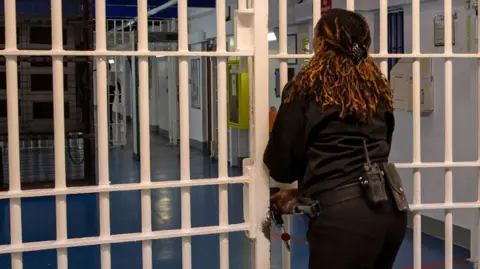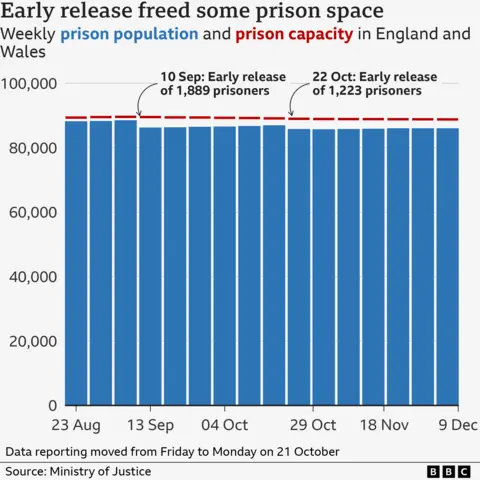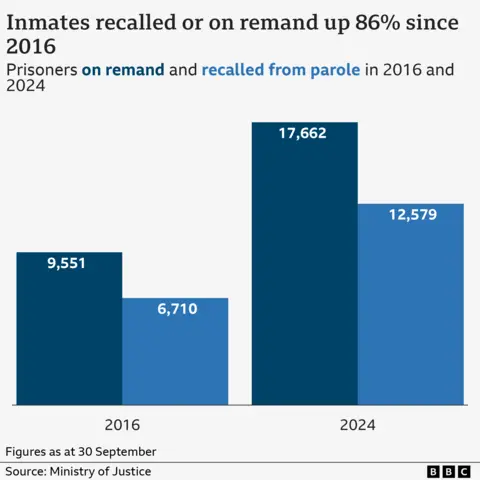How many people are in prison and who is being released early from jail?
 Getty Images
Getty ImagesA plan to tackle overcrowding in prisons will deliver 14,000 more prison places in England and Wales by 2031, the government has announced.
It involves building four new prisons, adding new blocks to existing prisons and opening temporary cells.
Some prisoners have also been released early and a review of sentencing has been announced, as ministers try to ease pressure on prison places.
Which prisoners are being released?
More than 3,100 prisoners have been let out of jail under the government's early release scheme in England and Wales, which started in September.
Eligible prisoners serving more than five years can now be automatically released after only 40% of their fixed-term sentence, rather than the usual 50%.
Sex offenders, and those serving sentences of four years or longer for serious violent offences, are not included.
Those convicted of domestic abuse and what the government calls "connected crimes", such as stalking, are also excluded.
The scheme only applies to a certain type of sentence, under which prisoners are automatically released after a set amount of time.
Anyone released will be monitored by the Probation Service, and this could involve the use of electronic tags and curfews.
The BBC learned that some former prisoners freed in September's first wave had not been fitted with tags, despite this being a condition.
It also emerged that 37 prisoners were wrongly released because their offences had been inaccurately recorded. They had all breached restraining orders, which should have disqualified them.
How many prisoners and prisons are there in the UK?
On 21 October, the prison population in England and Wales was 87,465, with 1,671 spare places.
Before the early release scheme began, Ministry of Justice data from 6 September showed the prison population was at a record high of 88,521.
The "usable operational capacity" - the total number of people a prison can hold while taking into account issues such as control and security - was 89,619, leaving spare capacity of just 1,098 places.
Prison population figures are published weekly and the latest release shows a population of 86,089 as of 9 December.

There are 122 men’s prisons, women’s prisons and Young Offender Institutions (YOIs) in England and Wales. HM Prison Service runs 105 and the others are managed by private companies.
In 2018 - the latest year for which comparable data is available - England and Wales had 150 prisoners per 100,000 people, the highest proportion in Western Europe.
Prisons in Scotland have also had to release people early to ease overcrowding. They held 8,260 people on 6 December..
It has emerged that more than one in 10 of the prisoners let out of Scottish prisons early were back in prison before their original release date.
In Scotland, there are 17 prisons, 16 operated by the Scottish Prison Service, and one by a private company.
The Northern Ireland Prison Service runs three prisons, which held just over 1,900 offenders on 6 December.
Why are prisons so full?
The prison population in England and Wales has been growing by around 4,500 a year - faster than new cells have been built.
The Institute for Government think tank says this is partly the result of longer sentences.
In 2023, the average prison sentence at Crown Courts in England and Wales - which deal with more serious offences - was more than 25% longer than in 2012.
For some crimes, the increase was greater. Sentences for robbery were 13 months longer on average in 2023 than in 2012, a rise of 36%.
Longer sentences mean more people in prison.
There has also been an increase in the number of prisoners on remand, who are waiting for their trial to start, or to be sentenced.
In September 2024, the remand prison population stood at 17,662, a record high. In 2016, it was about 10,000.

Some of this increase has been driven by a record number of Crown Court cases waiting to be heard.
More people than before are also being returned to prison for breaching their release conditions.
In September 2024, the number was around 12,500 - another record high - and roughly double the number in 2016.
Will the government build more prisons?
In 2021, the then Conservative government said it would build an extra 20,000 prison places in England and Wales "by the mid-2020s". However, only about 6,500 have been built to date.
The Labour government has pledged to continue building prison places to meet the 20,000 target.
It says it will speed up the planning application process by designating prisons as sites of "national importance" and giving ministers the power to approve them.
The government also plans to limit the prison population by changing the way sentencing works.
The former Conservative Justice Secretary David Gauke will lead a review designed to "end the prison crisis", and ensure that no government has to carry out an emergency release programme in the future.
His report, expected in Spring 2025, will look at replacing short prison sentences with new forms of community punishment, and whether the use of technology can improve rehabilitation.
